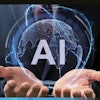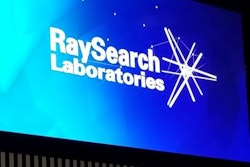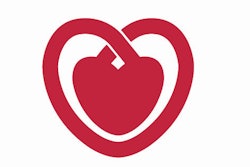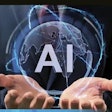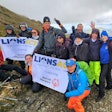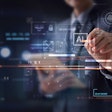Scylla and Charybdis were the terrifying sea monsters of Greek mythology that Odysseus had to navigate in order to complete his journey. Both represented a threat to the safety of his vessel and crew, but which of these represented the greater risk? Scylla was the man-eating multilimbed monster who would capture and devour the crew; Charybdis the terrifying whirlpool that would take them all to a watery grave.
Why am I comparing advances in technology and working practices with threatening mythological creatures? Surely these developments serve to advance the practice of radiology!
 Dr. Paul Dubbins.
Dr. Paul Dubbins.
The U.K. Royal College of Radiologists (RCR) reports that demand for diagnostic tests is far outstripping workforce growth, with a 29% shortfall in the consultant workforce. AI can potentially reduce the workload of radiologists by doing monotonous tasks in less time, freeing up clinicians to focus on more complex cases that require human interpretation.
In lung cancer screening, for example, it is possible to use AI algorithms to assist the radiologist in the detection and measurement of pulmonary nodules thus aiding early diagnosis. The current number of clinical radiologists would make the introduction of such a program without AI extremely challenging.
At a meeting organized by the British Institute of Radiology in 2018, Simon Rasalingham and Dr. Thomas Naunton Morgan, CEO and CMO respectively of Behold.ai, described their ambition to create a "super-human radiologist" using an AI-based red dotTM prioritization service to become much more efficient in. for example, plain film and CT head reporting. Indeed, at the same meeting radiologists were invited to "be happy and embrace machine learning."
AI, however, has been identified as both a gift and a threat to the clinical radiologist, and much has been made of the careful and thoughtful adoption of the technology into practice to ensure that the contribution of the clinical radiologist is clearly identified and preserved.
Indeed, at the very same meeting, Dr. Ian Francis described the modern radiologist as a potential "data wrangler" tied to their PACS workstation who doesn't see patients and has limited interaction with other clinicians. How is this different from sophisticated AI reporting?
All this was before the COVID-19 pandemic and the exodus of radiologists from departments to work from home. Were the comments of Dr. Francis indeed prescient?
There are undisputed advantages of the contribution of working from home (WFH) to the efficiency of radiologists: Fewer interruptions, limited travel, a controlled environment, and enhanced family life, leading to a better work-life balance. For the experienced radiologist, this is undoubtedly a boon: Improved efficiency of work, maintenance of accuracy of reports, better workflow -- perhaps the opportunity to work with other providers and not just the joy of reporting in your pajamas!
But what of the greater contribution of the radiologist? The title of clinical radiologist was a recognition of the very significant contribution to patient care that is made by our specialty. Interaction with patients, discussion with other medical specialties, working alongside our colleagues in the imaging department, contributing to multidisciplinary team meetings and other clinico-radiological meetings, and teaching.
Increasingly, there is a move to remote supervision of trainees (and other practitioners), and this may not even be contemporaneous -- the supervising radiologist providing advice on the modification of a report by a messaging system. Indeed, the advent of teleradiology has meant that not only can you report from home, but your home can even be in another country. (My wife has long been advocating that I come out of retirement to report from Sydney so that she can enjoy life on Bondi Beach while I sit in front of a workstation!)
How then will we be different from the ever-learning AI?
We need to consider how best to tackle the twin monsters who, unlike those of Greek myth, masquerade as our friends. Embrace the advantages that technology brings, certainly, but celebrate the differences that our humanity brings to the work.
It is important to manage the time that the radiologist spends in the department so that he/she can contribute directly to the development of knowledge and experience of our trainees, as well as ensure that newly appointed radiologists are adequately supported. It is easier to recognize a lack of confidence in a young colleague if you are meeting with them and sharing case studies.
Being available for discussion with your clinical colleagues and contributing to the planning of optimal imaging protocols in complex cases -- both of these things and more are features of a clinical radiologist.
Reporting remotely is an extremely valuable tool to improve efficiency, but it has very significant limitations beyond those I have described. If the radiologist is reporting from another country then he/she has greater difficulty in contributing fully to patient management and cannot be a part of clinically important events such as the multidisciplinary team meeting.
Maybe advances in technology such as the development of virtual reality will eventually allow a greater personal, though remote, contribution to patient care, radiology training, and professional interaction.
Until then, the twin benefits of AI and WFH should be carefully managed to ensure that the professional isolation of WFH doesn't consume us and that we are not then lost in the maelstrom of AI.
Dr. Dubbins is a consultant advisor in radiology based in Berkhamsted, U.K. He previously worked as a consultant radiologist at Plymouth Hospitals National Health Service Trust and is a past vice president of the RCR.
The comments and observations expressed herein do not necessarily reflect the opinions of AuntMinnieEurope.com, nor should they be construed as an endorsement or admonishment of any particular vendor, analyst, industry consultant, or consulting group.

